Chandra: A biographical portrait
DOI: 10.1063/1.3529401
The simple is the seal of the true.
And beauty is the splendor of truth.
The simple is the seal of the true.
And beauty is the splendor of truth.
With the words above, Subrahmanyan Chandrasekhar, popularly known as Chandra, concluded his Nobel Prize lecture on 8 December 1983. Toward the end of his talk, he was describing black holes in the astronomical universe, explaining the simplicity in the underlying physics and the beauty of their mathematical description within the framework of Einstein’s theory of relativity. “They are,” he said, “the most perfect macroscopic objects there are in the universe.”
The Nobel Prize in Physics brought an extremely private and somewhat shy individual into the limelight. For newspaper journalists and broadcast interviewers, neither the simplicity of the physics of the black holes nor the mathematical beauty of their description was of major concern; the pronunciation of Chandra’s full name seemed to present them with an astronomical difficulty in and of itself.
The announcement of the prize he shared with William Fowler was greeted with joy and appreciation throughout the scientific world, and he was soon inundated with telephone calls, telegrams, and letters of congratulations and good wishes from his former students, associates, heads of scientific institutions, and governments. Most considered the prize belated and long overdue. But for Chandra, who had been critical of the atmosphere it creates — and of the ways in which some people seemed to go after it—it was to a large extent distorting to science and its true pursuit. He had never considered himself as a possible candidate, since his areas of research, pursued in a single-minded quest for a personal perspective, had not led him into areas that were in the science spotlight.
Lahore and Madras, 1910-25
Chandra was born on 19 October 1910 (“19-10-1910,” as Chandra was fond of saying with a rare chuckle) in Lahore, Pakistan (then a part of colonial British India). His father, Chandrasekhara Subrahmanyan Ayyar, was in the government service, the deputy auditor-general of the North Western Railways. Chandra was the first son and the third child in a family of four sons and six daughters. His mother, Sitalakshmi, was a woman of great talent and intellectual attainment. She married young and received only a few years of elementary schooling, yet she managed to continue her education while bearing 10 children and learned English well enough to adapt Henrik Ibsen’s A Doll’s House and translate a long story by Tolstoy into Tamil. Intensely ambitious for her children, she was to play a pivotal role in Chandra’s career.
Being the first son, Chandra inherited the name of his grandfather, Ramanathan Chandrasekhar (referred to as R. C. hereafter). R. C. had been the first in the family to depart from traditional village life and pursue an English education. If, after graduating from high school in 1881, he had continued his college education and completed his BA degree as expected, he probably would have ended up in a high British government post. But he took his Western education seriously: He read English literature and philosophy extensively, studied mathematics and physics, and in general pursued what interested him most rather than what was required of him. This remarkable person, 1 who transformed the lives of his future generations, built a fine home library, which proved to be a very valuable resource to them. Chandra inherited not only his grandfather’s name but also his independent streak in the pursuit of knowledge.
Chandra’s early education was at home under the tutelage of his parents and private tutors. When he was 11 and the family had permanently settled in Madras (now Chennai), he began his regular schooling at the Hindu High School in the city’s Triplicane neighborhood.
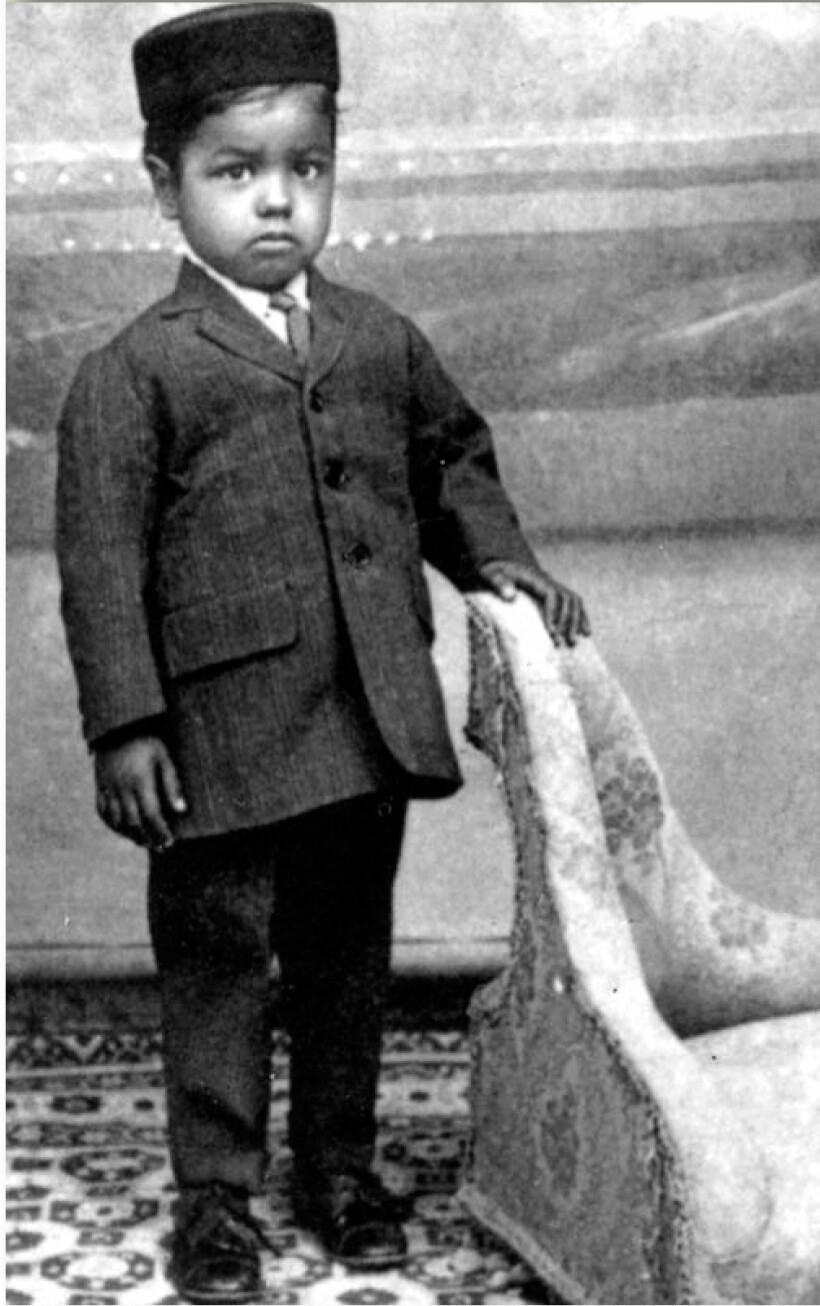
Subrahmanyan Chandrasekhar, age 6.
AIP EMILIO SEGRÉ VISUAL ARCHIVES, GIFT OF KAMESHWAR WALI
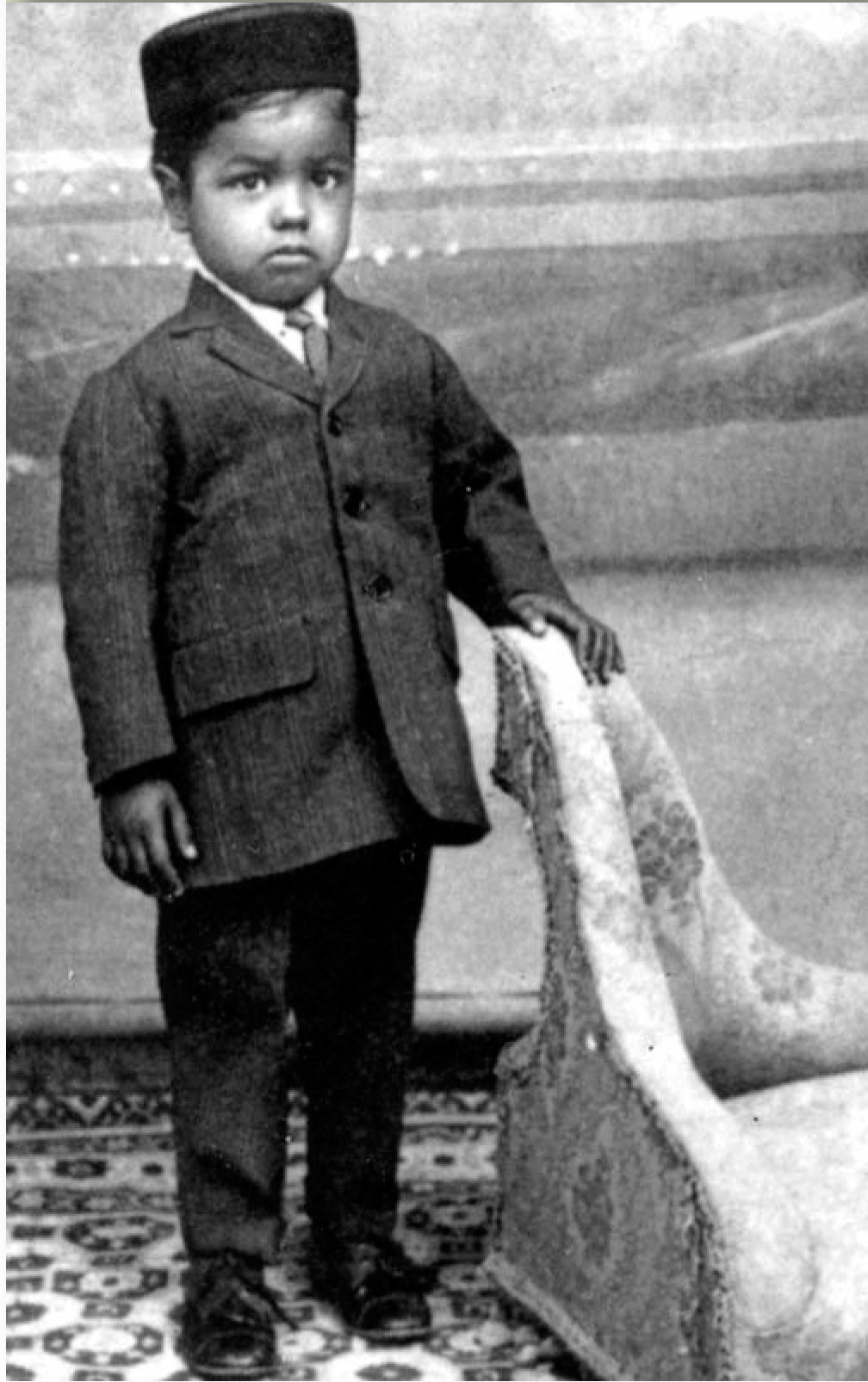
Chandra found formal school neither easy nor pleasant. His education at home under private tutors had allowed him the freedom to study what he liked (mainly English and arithmetic). Now he was suddenly required to study history, geography, and general science and was subjected to periodic examinations. It was a disappointing first year, but the promise of the following year’s curriculum, which included algebra and geometry, was enough to get him excited. Without waiting for classes to begin, he got the books and studied on his own during the summer vacation. By the time he started his second year, he knew all the geometry and all the algebra the school was going to teach, and in fact more. He kept up his studying during the following three vacations and did extremely well in high school; he became a freshman at Presidency College in Madras when he was only 15 years old.
Those early years of learning were happy years for Chandra. Though the family was growing—a new child every two years or so—his father’s income provided a comfortable life. In 1924, Chandra’s father built his own house, named Chandra Vilas, in Mylapore, a prestigious suburb of Madras. And because he was in the railway services, he and the family received free railway travel or reduced fares, so they got together more frequently than they could otherwise. The children traveled to all parts of India—a privilege few Indians could afford. Grandfather R. C.’s efforts had paved the way for a new urban life for his children and grandchildren.
Education and urban life could not completely change centuries of tradition, however. Chandra’s father, a highly cultivated individual, widely read and traveled, was a traditional father. He was authoritarian and demanded unquestioned obedience. Reserved and undemonstrative, he remained aloof from his children; they in turn could not share their innermost thoughts or feelings with him. Deeper connections were left to Chandra’s mother. Sitalakshmi was the vital force of the family, keeping it together, helping the children with their studies, and meeting their needs. Without imposing strict religious discipline, she infused them with the cultural heritage and ideals of Hinduism. Chandra, the eldest son, held a special place in her heart.
Presidency College, 1925-30
Chandra’s freshman and sophomore years (1925-27) proceeded smoothly. After he completed his second year with distinction in physics, chemistry, and mathematics, Chandra’s next step was to work toward a bachelor’s degree.
He wanted to take honors mathematics; he had not only excelled in his mathematics studies, he had long been under the spell of the legendary Srinivasa Ramanujan. Chandra was not quite 10 years old when his mother told him of the death of a famous Indian mathematician named Ramanujan who had gone to England some years earlier, collaborated with some famous English mathematicians, and returned to India only recently with international fame as a great mathematician. Ever since, Ramanujan was a source of inspiration.
Unfortunately, Chandra’s father had different ideas. He wanted Chandra to aim for the Indian Civil Service examination to become an ICS officer in His Majesty’s government. That was certainly the practical thing for such a brilliant young man to do. From his high-school days, however, Chandra had determined to pursue a career in pure science. He had as an example his uncle Chandrasekhara Venkata Raman (popularly known as C. V. Raman), who had resigned a highlevel government post to pursue an academic and research career in physics. Although Chandra wanted to study pure mathematics, as a compromise to his father he opted to study physics and enrolled himself for a BSc honors degree.
The year 1928 proved an extraordinary time for Chandra. First of all, in February and March of that year, Raman, along with Kariamanickam Srinivasa Krishnan, made a fundamental discovery in the molecular scattering of light, later to become known as the Raman effect. Chandra spent the summer months in Calcutta, staying with Raman and working in the laboratory where the discovery was made. He knew enough theoretical physics to participate in the excitement and even explain to the experimentalists the significance of the discovery. He came to know Krishnan very well. Although 12 years apart in age, the two struck up a friendship that lasted through Krishnan’s lifetime.
Soon after his return to Madras, Chandra learned from Krishnan that Arnold Sommerfeld was to visit India on a lecture tour in the fall, and Madras and Presidency College were on his itinerary. For Chandra that was most exciting news— a rare opportunity to hear the famous man, especially since he had read Sommerfeld’s book Atomic Structure and Spectral Lines and worked through it on his own. Chandra dreamed of meeting him, impressing him with his knowledge of atomic physics, and discussing plans for his research. Indeed, after the lecture in the science college, Chandra made arrangements to see him in his hotel room the following day. Chandra approached him with the brash confidence of a young undergraduate, but Sommerfeld shocked him by telling him that the quantum theory in the book was out-dated. He told Chandra about recent discoveries—Erwin Schrödinger’s wave mechanics and the new quantum mechanics of Werner Heisenberg, Paul Dirac, Wolfgang Pauli, and others. Chandra had also studied classical Maxwell-Boltzmann statistics. Sommerfeld told him that too had undergone a fundamental change in the light of the new quantum mechanics. Seeing a crestfallen young student before him, Sommerfeld offered Chandra the galley proofs of his as yet unpublished paper that contained an account of the new Fermi-Dirac quantum statistics and its application to the electron theory of metals.
Chandra would later characterize that encounter as the “single most important event” in his life. He immediately launched on a serious study of the new developments in atomic theory. Sommerfeld’s paper was sufficient for him to learn about Fermi-Dirac statistics and prepare, within a few months, a paper entitled “The Compton Scattering and the New Statistics.” Chandra thought it significant enough to merit publication in the Proceedings of the Royal Society. But the society required the papers to be communicated by a fellow, a member of the society. As he was browsing through the newly arrived journals in the university library, he had come across Ralph Fowler, a fellow, who had just published his pioneering paper on the theory of white dwarfs based on the new Fermi-Dirac statistics. So Chandra sent his paper to Fowler, who agreed to communicate it and got it published. That chance circumstance was to have a profound influence on Chandra’s future scientific career.
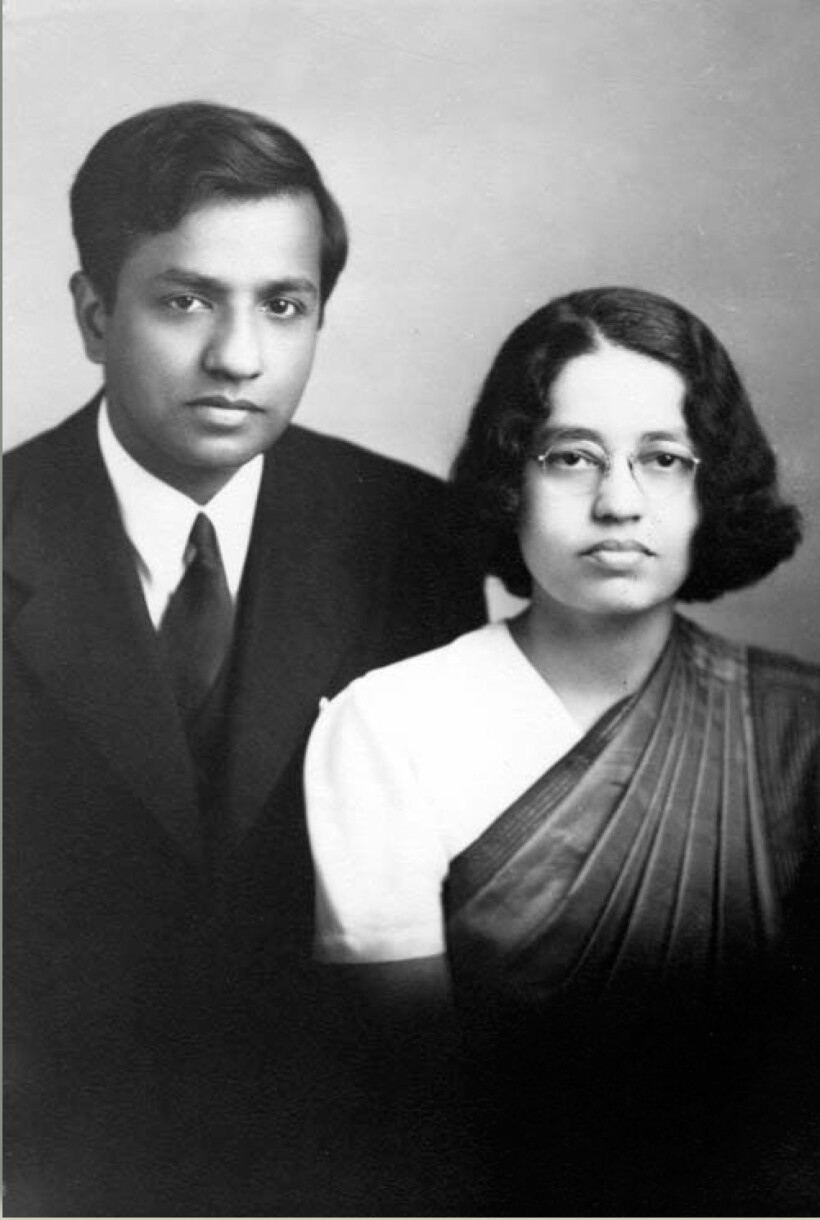
Subrahmanyan Chandrasekhar and his wife, Lalitha, in Williams Bay, Wisconsin, circa 1940.
AIP EMILIO SEGRÉ VISUAL ARCHIVES, GIFT OF KAMESHWAR WALI
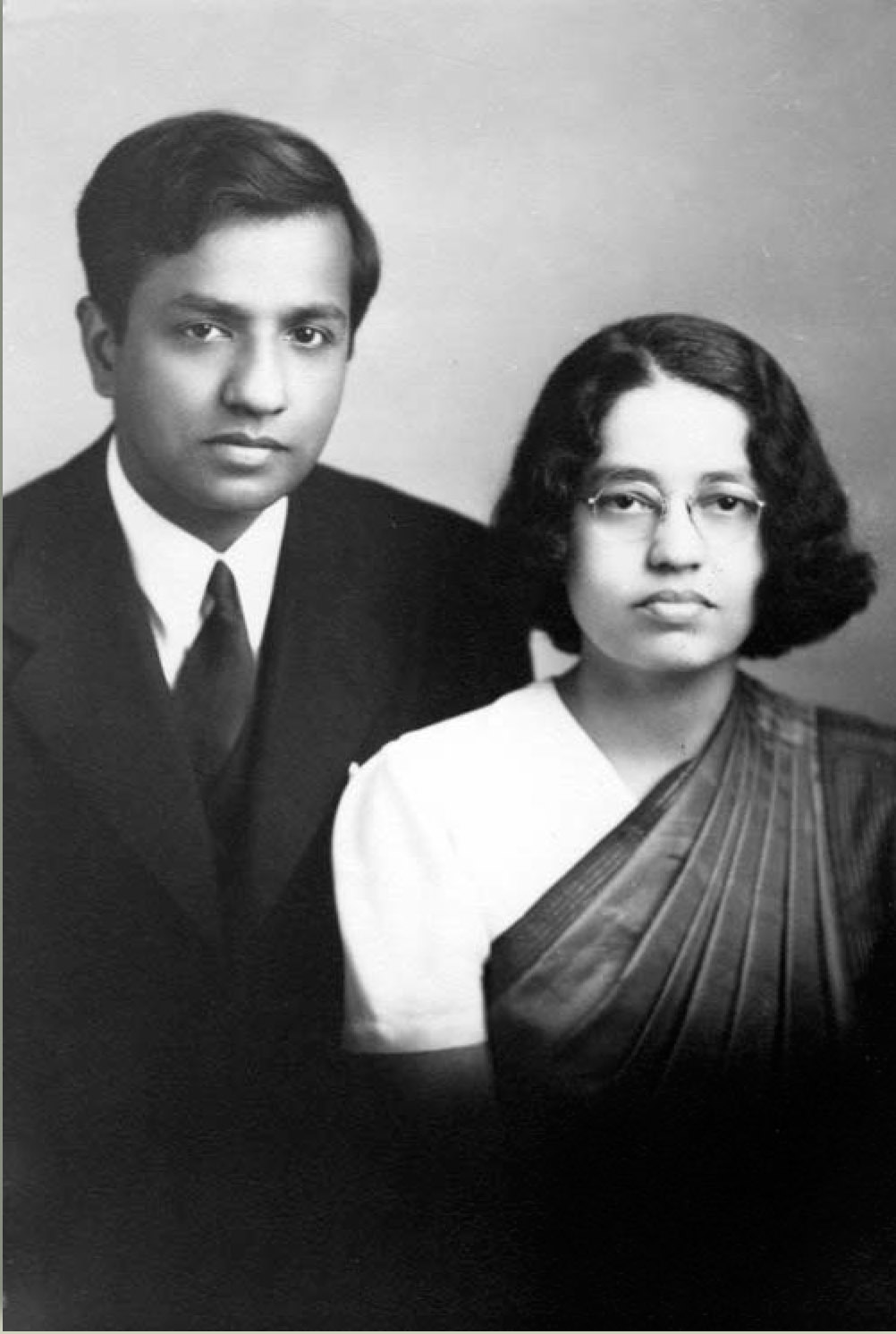
Along with his studies, Chandra continued his research, and by the end of his second undergraduate year he had a formidable list of papers to his name. His final year in college was equally eventful. First Heisenberg came through Madras on a lecture tour in October 1929. Krishnan had put Chandra in charge of showing Heisenberg around Madras. A day alone with the famous Heisenberg was an exhilarating experience for young Chandra. In addition, his activities and his prominence in his studies and research had attracted the attention of Lalitha Doraiswamy, a fellow undergraduate who would become his wife. A few months later, in January 1930, he attended the Indian Science Congress Association meeting in Allahabad. He met the celebrated astrophysicist Meghnad Saha and his students and was pleasantly surprised to know his work had become well known. Chandra had the honor of being a dinner guest in the company of some distinguished senior Indian scientists. To top it all, on his return, he was called into the college principal’s office. Principal Philip Fyson told him, in strict confidence, that he was going to be offered a Government of India scholarship to continue his studies in England. The scholarship was special, more or less created for him. On 22 May he received official notification that he had been awarded the scholarship and that he could proceed to make the necessary travel arrangements. Chandra decided to go to Cambridge University and study under the guidance of Fowler.
The opportunity to go abroad for advanced studies, ordinarily so difficult a matter both financially and logistically, came to Chandra so unexpectedly and so easily. Nonetheless, he had to face a difficult personal conflict. His mother had been ill since the summer of 1928, just before his encounter with Sommerfeld, and her illness had taken a serious turn. Although she had ups and downs, after two years of every kind of treatment it had become clear she was not going to get well again. If he went to England, he might never see her again.
Tradition and pressure from friends and relatives mounted against leaving his mother in such a condition. But Sitalakshmi herself intervened. Her insistence and persuasion and her solemn desire not to stand in the way of his future prevailed. With her promise of getting well, she persuaded the reluctant Chandra to proceed. Chandra left India on 31 July 1930, leaving behind a loving and caring family, and Lalitha.
Cambridge and Copenhagen, 1930-33
Before leaving India, Chandra had studied Fowler’s paper more carefully and further developed the theory of white dwarfs to obtain a more detailed picture of them. On his long voyage from India, as a result of musings and calculations, he found Fowler’s theory needed modifications to include special relativistic effects that led to a startling conclusion: There was an upper limit on the mass of a star that could become a white dwarf in its terminal stage (see the article by Freeman Dyson, page 44), and that limit could be expressed in terms of fundamental atomic constants.
When Chandra met Fowler for the first time, he handed over two papers, one he had completed in India and the other about the startling discovery he had made on his journey. Fowler was extremely impressed with this young, new student who exhibited so much independence and initiative. After some discussion, Fowler was quite pleased with the first paper, which had extended his own work. However, he was not so sure of the second paper. He offered to send it to Edward Arthur Milne, who Fowler thought was more familiar with the subject. After getting no response from Fowler or Milne for months and seeing no possibility of its publication in Monthly Notices of the Royal Astronomical Society, Chandra sent it to the Astrophysical Journal on 12 November 1930; it was published the following July. 2
Among the lectures Chandra attended during his first year were Dirac’s lectures on quantum mechanics. He had studied Dirac’s book on his own, but he nevertheless attended the lectures faithfully, even though Dirac essentially copied onto the blackboard from his book. Dirac became his official adviser during the second term when Fowler left Cambridge on sabbatical, and Chandra came to know Dirac quite well. “He was very human, extremely cordial to me in a personal way,” Chandra recalled. “Even though he was not very much interested in what I was doing, he used to have me for tea in his rooms in St. John’s about once a month. He also came to my rooms for tea and, on some Sundays, used to drive me out to fields outside Cambridge where we used to go for long walks.”
Chandra continued to do research on relativistic ionization and on stellar atmospheres and began a correspondence with Milne, who was quite receptive of his work. Milne’s encouragement as well as his critical comments were of great help to Chandra during those early days. Within six months they had established a strong rapport, and Milne suggested collaboration and joint publications. Chandra’s research efforts were recognized—he was elected to Trinity College’s Sheep Shanks Exhibition, a special honor bestowed every year to one candidate for proficiency in astrophysics, with an award of £40. He received a congratulatory note from Arthur Eddington with an invitation to meet him on 23 May 1931.
However, on 21 May 1931, Chandra received a devastating telegram:
Mother passed away Thursday 2PM Bear patiently.
Mother passed away Thursday 2PM Bear patiently.
Chandra used to write home twice a week to his father and at least once a month to his younger brother Balakrishnan, and also to his mother in Tamil; they were probably the only diversion from his routine. The letters to his father reveal in depth Chandra’s life: his work, study, and leisure routines; his worries; his excursions and walks; the scientists around him; financial details (how he spent and saved); and his diet and his health (as indicated by his weight). His mother’s health was constantly on his mind, and in every letter he inquired about it. As her health went through rapid ups and downs, he always hoped she would get better. But that was not to be.
Alone, with no one to share his grief, he went to the riverbank, sat, and wept. Bear patiently, he told himself. He kept his appointment with Eddington two days after the news, received congratulations, and discussed his work, all the while feeling empty inside.
Work was the only panacea for loneliness and grief. He was working on stellar coefficients of absorption with Milne and had plans to spend the summer in Oxford. But after the news of his mother’s death, he felt the need for a change from the drudgery of Cambridge and the past 11 months of ceaseless study and research. He thought a few months of diversion on the continent would provide the necessary relief. He spent the summer at the Institute for Theoretical Physics in Göttingen, Germany, where Max Born was working. Although the summer was supposed to be a vacation for Chandra, it became mostly a change of place and a change of study topics. But it helped to broaden his circle of friends on the continent. He returned to Cambridge in early September to begin his second academic year.
As he continued his research and piled up publications, some in collaboration with Milne, a conflict slowly brewed in Chandra’s mind. He was in astrophysics by sheer chance— on his own, he had found a problem to work on. He began to have nagging doubts about the value of the work he was doing in astrophysics, as he was not receiving any encouragement in Cambridge. What about his true love—pure mathematics? He had come into physics due to the insistence of his father. Failing to pursue pure mathematics, he felt he would be happier if he could devote himself to pure physics, which he saw as the frontier field in which fundamental discoveries were taking place. The star-studded Cavendish Laboratory was the center of activity.
Dirac was his mentor, but because of a sense of loyalty to Fowler, he hesitated to tell Dirac he wanted to switch fields from astrophysics to theoretical physics. Finally, toward the end of his second year, he revealed to Dirac how unhappy he was in Cambridge and with what he was doing. Dirac, not being in astrophysics, was in no position to convince him otherwise. But he was very nice and understanding, and sympathized with Chandra’s situation. He strongly urged Chandra to go to Niels Bohr’s Institute for Theoretical Physics in Copenhagen, where he would find a better climate with friendly men who, though younger, were “big men” in physics.
Chandra took Dirac’s suggestion and spent his final year in Copenhagen. The atmosphere at the institute was indeed, as Dirac indicated, quite unlike Cambridge. It was extremely friendly and truly international. Chandra found himself in a group of enthusiastic young people, including Max Delbrück, George Placzek, Victor Weisskopf, E. J. Williams, and Léon Rosenfeld. Chandra was particularly drawn to Rosenfeld, from Belgium, whose fiancée was studying astrophysics. There were also frequent visitors, including Oskar Klein and Heisenberg. With new friendships, tea every Sunday at Bohr’s house, and walks and bicycle rides in the country, Chandra’s life took on a new communal dimension.
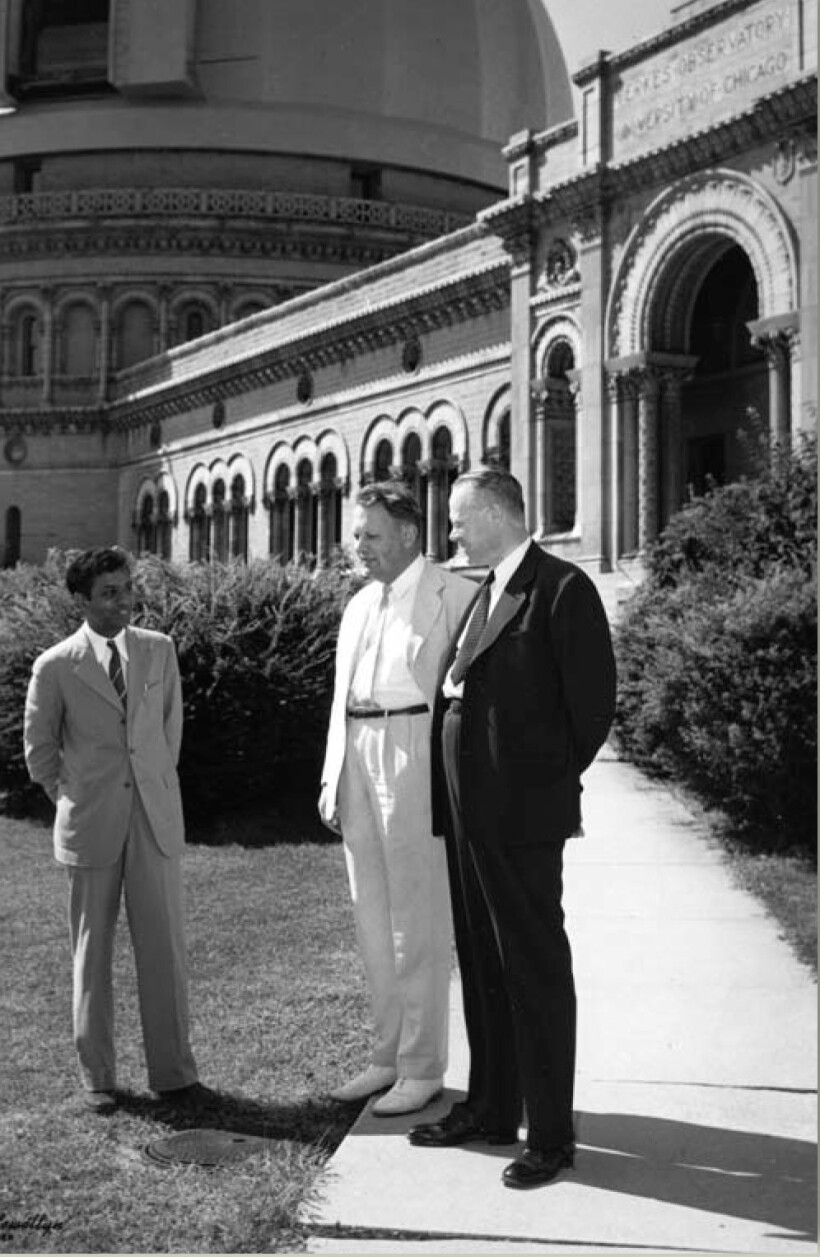
Yerkes Observatory, part of the University of Chicago and located in Williams Bay, Wisconsin, was home to Subrahmanyan Chandrasekhar (left) for 27 years.
AIP EMILIO SEGRÉ VISUAL ARCHIVES, GIFT OF KAMESHWAR WALI
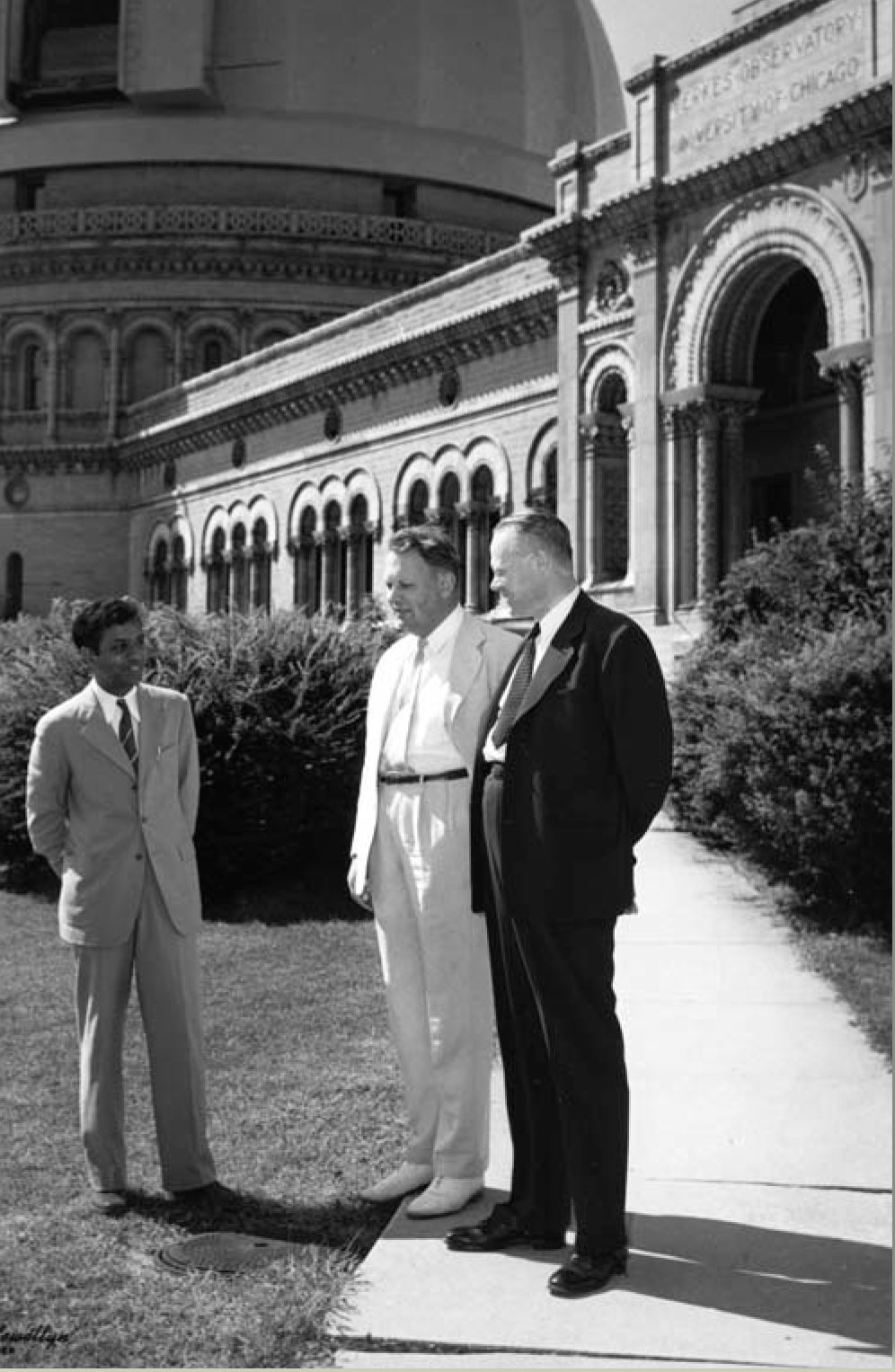
He was also happy to be working on a problem in physics that Dirac had suggested: generalizing Fermi-Dirac statistics to more than two particles. Unfortunately, that did not work out. Chandra believed he had solved the problem and wrote a paper titled “On the Statistics of Similar Particles.” Bohr and Rosenfeld read the paper and Bohr communicated it for publication to the Proceedings of the Royal Society. But Dirac found an error and convinced Chandra that he had not solved the problem Dirac had suggested. The paper had to be withdrawn.
Chandra had hoped to change fields from astrophysics to pure theoretical physics, but his lack of success with Dirac’s problem put an end, at least for then, to that idea. Physics was the fundamental science, and while Chandra socialized with physicists like Weisskopf, Delbrück, Hans Kopfermann, and others who appeared to be at the hub of important discoveries, he was not part of their science.
As December came along, it became clear to Chandra that he had to get his thesis ready to get his degree before the end of his scholarship in August 1933. Back to astrophysics, he set himself to prepare for his thesis a series of papers on distorted polytropes. (A polytrope is gaseous material in equilibrium under its own gravity and in which the pressure and density have a power-law relationship.)
A fellowship and an encounter, 1933-36
The degree became just a formality. Fowler did not find it necessary even to read Chandra’s thesis. Chandra felt his future to be bleak, however. His scholarship would end in August and he would be required to return to India as soon as he completed his PhD degree. He was also under pressure from his father to return, but there was no promise of a suitable position that would allow him to continue his research. He was determined to extend his stay in Europe. He would seek support from Cambridge and Copenhagen; if nothing materialized, he had sufficient savings to stay at least six months anywhere in Europe. With little hope, he applied for a fellowship at Trinity College, a wild dream. If it came true, he would have four more years in Cambridge with free rooms in the college, dining privileges at the high table, and an allowance of £300 per year. Fowler was not very optimistic, though—the fellowship was open to candidates from all fields and the competition was formidable.
The dream did come true. The only other Indian who had been elected a Trinity fellow was Ramanujan some 16 years before. Chandra’s Cambridge life became more enjoyable. He was no longer as lonely. He felt assured that his work would be appreciated. Astrophysics was going to be his predominant area of research, at least for the next four years. As a Trinity fellow, he could become a fellow of the Royal Astronomical Society on his own merit and did so without much ado. A trip to London to attend RAS meetings every second Friday of the month became a routine in his life and allowed him to make a mark on the tradition-ridden, hierarchical scientific surroundings. The Trinity fellowship also brought an opportunity to visit Russia during the summer of 1934.
The Russian visit renewed Chandra’s interest in his own earlier work on the theory of white dwarfs. Neither Fowler nor Milne appreciated the startling discovery he had made. During the intervening years, he had occupied himself with other problems. In Russia, he gave talks about his white dwarf work, and Viktor Ambartsumian, in particular, was quite enthusiastic about his discovery. Ambartsumian suggested Chandra should work out the exact, complete theory devoid of some simplifying assumptions he had made.
During the fall months of 1934, Chandra involved himself in detailed, tedious numerical calculations in order to obtain as exact a theory of the white dwarf as one could construct within the framework of relativistic quantum statistics and the known features of stellar interiors. He accomplished the task by the end of 1934 and submitted two papers to the RAS. At the society’s invitation, he presented a brief account of his results at the January 1935 meeting. His findings raised challenging and fundamental questions: What happens to the more massive stars as they continue to collapse? Are there other terminal stages different from white dwarfs? Instead of getting appreciation and recognition for a fundamental discovery, Chandra unexpectedly faced what amounted to a public humiliation. No sooner had he presented his paper than Eddington, who had been his mentor and who had followed his work closely, ridiculed the basic idea of relativistic degeneracy on which Chandra’s work was based. Eddington characterized the theory as amounting to reductio ad absurdum behavior of the star, tantamount to stellar buffoonery. 3 Chandra sought the support of eminent physicists, who without exception agreed that his derivations were flawless, but Eddington’s authority prevailed among the astronomers as he continued to attack the theory.
Eddington’s denunciation was a traumatic experience for Chandra. In the face of such opposition, he decided to gracefully withdraw from the controversy instead of engaging in a dogged fight. He stopped further work on the theory of white dwarfs and went on to research in other areas. As he said, 4
I foresaw for myself some thirty to forty years of scientific work, and I simply did not think it was productive to constantly harp on something which was done. It was much better for me to change the field of interest and go into something else. If I was right, then it would be known as right. For myself, I was positive that a fact of such clear significance for evolution of the stars would in time be established or disproved. I didn’t see a need to stay there, so I just left it.
I foresaw for myself some thirty to forty years of scientific work, and I simply did not think it was productive to constantly harp on something which was done. It was much better for me to change the field of interest and go into something else. If I was right, then it would be known as right. For myself, I was positive that a fact of such clear significance for evolution of the stars would in time be established or disproved. I didn’t see a need to stay there, so I just left it.
More than two decades passed before the Chandrasekhar limit became an established fact. It has been hailed as one of the most important discoveries of the last century, since it paved the way to the discovery of the other two presently known terminal stages of stars: neutron stars and black holes.
A voyage to the New World, 1936
During the fall of 1935, Chandra received an offer of a lectureship at Harvard University from Harlow Shapley, director of the Harvard College Observatory. The appointment could begin in December or January and required at least three months’ stay. Chandra accepted the offer and had a highly successful and productive first visit to America from 30 December 1935 to 25 March 1936. He attended the American Astronomical Society meeting at Princeton University, gave 10 lectures at the observatory, and at an invitation from its director, Otto Struve, visited the Yerkes Observatory in Williams Bay, Wisconsin. A future for Chandra in America seemed to chart itself without any effort on his part. He received two offers, one from Harvard and the other from Yerkes. At Harvard, he would join the Society of Fellows, and at Yerkes he would have a research associateship. He received the latter offer aboard ship during his return voyage to Cambridge, and it came directly from Robert Hutchins, the president of the University of Chicago, with a prepaid cable for his answer.
Chandra chose to accept the offer from Yerkes, persuaded by Struve’s arguments in favor of close cooperation between a theorist like him and observational astronomers. With Gerard Kuiper and Bengt Strömgren (a good friend from Copenhagen) also coming to Yerkes, a formidable group of young theorists and observational astronomers was in the making. Thus Chandra felt that as far as his scientific career was concerned, his immediate future had been virtually settled for him. It was time to think of other matters before setting forth to America. He had been away from home for nearly six years and it was time to return. He planned a short trip of three months. There was also the matter of marriage. Chandra had met Lalitha when both were undergraduate students at Presidency College, and they had developed an “understanding” of a lifelong commitment. Though the intervening six years had raised concerns of their future, once they met again in Madras all the doubts and uncertainties vanished. They were married on 11 September 1936, and after one short month in Cambridge they set forth to America.
Williams Bay and Chicago, 1937-95
Chandra and Lalitha, newly married, arrived in the US in 1937, and Chandra joined the faculty of the University of Chicago at Yerkes Observatory. He immediately took on the task of developing a graduate program in astronomy and astrophysics. It wasn’t too long before his reputation as a teacher, his youth, and his enthusiasm for research began to attract students from all parts of the world. As a teacher and a lecturer, Chandra was a grand master who brought elegance and scholarship that literally charmed his listeners and kept them spellbound. He was also the sole editor of the Astrophysical Journal during the years 1952-71. He played a decisive role in transforming the journal, which had been essentially the private property of the University of Chicago, into the national journal of the American Astronomical Society and one of the foremost astrophysics journals in the world.
Chandra and Lalitha lived in Williams Bay for the next 27 years. In 1964 they moved to the Hyde Park neighborhood of Chicago, near the university. Elected a fellow of the Royal Society of London in 1944, Chandra was named the Morton D. Hull Distinguished Service Professor at the University of Chicago in 1946 and remained at the university until his death in 1995.
The judgment of posterity
Chandra often told his life story as follows:
I left India and went to England in 1930. I returned to India in 1936 and married a girl who had been waiting for six years, came to Chicago, and lived happily thereafter.
I left India and went to England in 1930. I returned to India in 1936 and married a girl who had been waiting for six years, came to Chicago, and lived happily thereafter.
It may be so. But the Chandra one knows is the product of the complexities of three widely different countries: India, the land of his birth with its ancient culture and traditions, which undoubtedly influenced his early childhood and youth; England, the land of colonial masters, where his scientific research mushroomed and matured; and finally America, his adopted homeland, where he continued his research and became one of the foremost scientists of the 20th century.
Although there have been many scientists whose discoveries had perhaps greater impact and whose names have become more illustrious, in my opinion Chandra stands alone for his single-minded pursuit of his science and his devotion to the life of the mind. His extraordinary success in his scientific work was marked by an extraordinary effort, an intensity, a fervor for completeness, elegance, and above all else a personal, aesthetic perspective that extended beyond his well-known scientific papers and monographs. For example, when he was chosen for the University of Chicago’s 1975 Ryerson Lecture, Chandra said that his preparations for his talk, “Shakespeare, Newton, and Beethoven, or Patterns of Creativity,”
consisted in reading several biographies of Shakespeare, his sonnets (in A. L. Rowse’s editions) very carefully, and listening with the text (together with Ruth and Norman Lebovitz) to all the great tragedies (in their Marlowe editions); reading several biographies of Beethoven (particularly Turner’s and Sullivan’s); and similarly reading several biographies of Newton; besides, the lives of Rutherford, Faraday, Michelson, Moseley, Maxwell, Einstein, Rayleigh, Abel; and books and essays by Hadamard, Poincaré, and Hardy; and the works of Keats and Shelley and most particularly Shelley’s A Defense of Poetry and King-Hele’s biography of Shelley.
5
consisted in reading several biographies of Shakespeare, his sonnets (in A. L. Rowse’s editions) very carefully, and listening with the text (together with Ruth and Norman Lebovitz) to all the great tragedies (in their Marlowe editions); reading several biographies of Beethoven (particularly Turner’s and Sullivan’s); and similarly reading several biographies of Newton; besides, the lives of Rutherford, Faraday, Michelson, Moseley, Maxwell, Einstein, Rayleigh, Abel; and books and essays by Hadamard, Poincaré, and Hardy; and the works of Keats and Shelley and most particularly Shelley’s A Defense of Poetry and King-Hele’s biography of Shelley. 5
Chandra often quoted a letter from Milne:
Posterity, in time, will give us all our true measure and assign to each of us our due and humble place. He really succeeds who perseveres according to his lights, unaffected by fortune, good or bad. And it is well to remember there is no correlation between the judgment of posterity and the judgment of contemporaries.
Posterity, in time, will give us all our true measure and assign to each of us our due and humble place. He really succeeds who perseveres according to his lights, unaffected by fortune, good or bad. And it is well to remember there is no correlation between the judgment of posterity and the judgment of contemporaries.
This first centennial celebration of Chandra’s birth may or may not be the moment to determine the true measure of posterity. However, the Chandrasekhar Centennial Symposium, held at the University of Chicago in October, and this special issue of Physics Today mark the beginning of that posterity’s judgment to bestow on him his due place as a scientist of rare stature and greatness.

The National Medal of Science being presented to Subrahmanyan Chandrasekhar by President Lyndon B. Johnson in 1967.
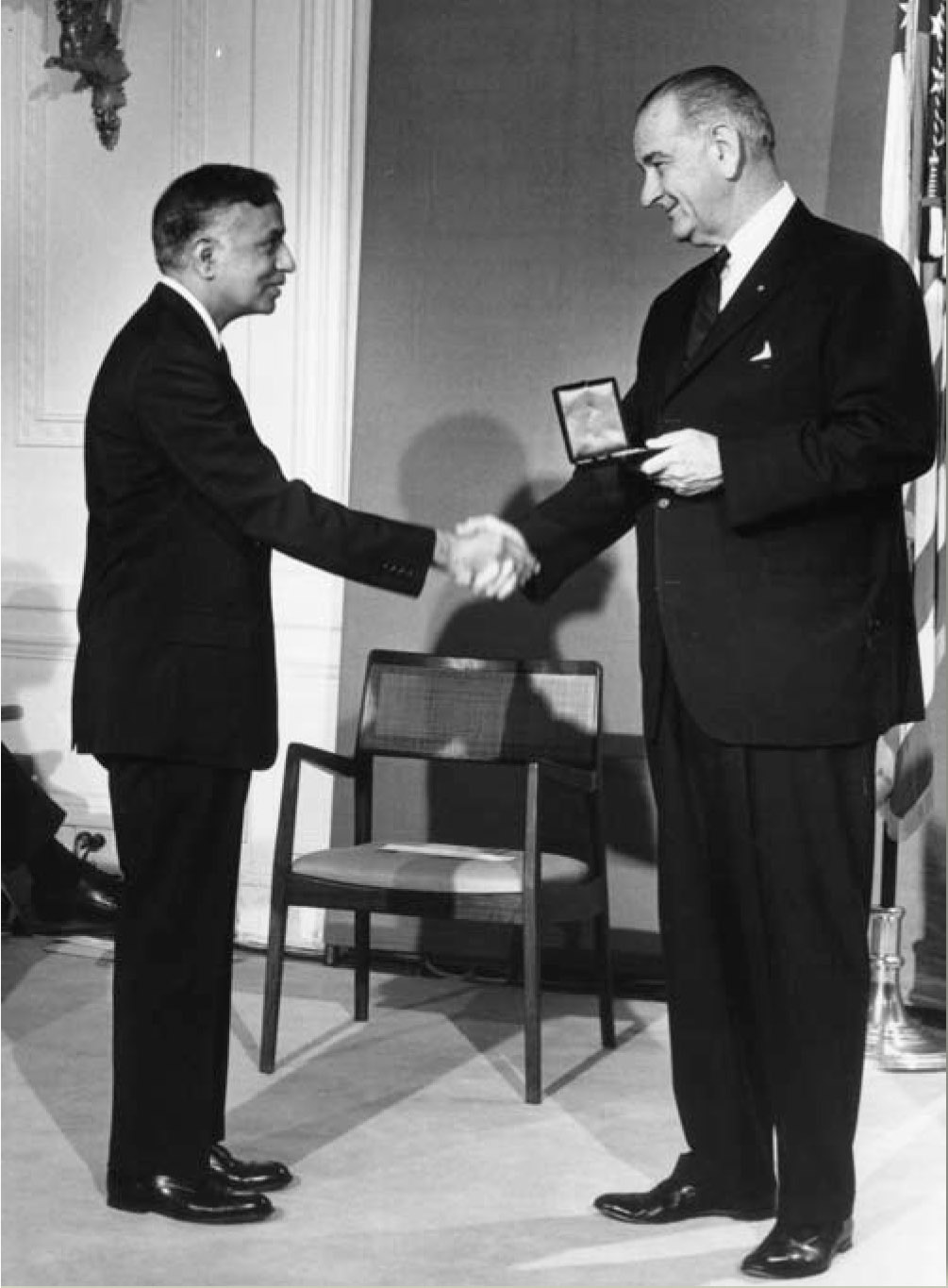
References
1. For more details, see C. S. Ayyar,“Family History” (1946), Subrahmanyan Chandrasekhar Papers, box 6, folder 4, Special Collections Research Center, University of Chicago Library.
2. S. Chandrasekhar, Astrophys. J. 74, 81 (1931). https://doi.org/10.1086/143324
3. For details, see, for instance, K. C. Wali, Chandra: A Biography of S. Chandrasekhar, U. Chicago Press, Chicago (1991), p. 124.
4. Ref. 3, p. 146.
5. K. C. Wali, ed.,A Scientific Autobiography: S. Chandrasekhar, World Scientific, Hackensack, NJ (in press).
More about the Authors
Kamesh Wali is the distinguished research professor emeritus in the department of physics at Syracuse University in Syracuse, New York.
Kameshwar C. Wali. Syracuse University, Syracuse, New York, US .




